The State Of Drinking Water: A Roundup Of ACE12 From Dallas
July 3, 2012
By Kevin Westerling, Editor, Water Online
 Steering
clear of the “everything’s bigger in Texas” puns, those familiar
with the American Water Works Association’s Annual Conference &
Exposition (ACE) know just how big — literally, and in terms of
importance — this event is to the drinking water industry. The 131st
edition of the event, ACE12, was held at the Dallas Convention
Center from June 10 to 14, and with roughly 10,000 attendees and 500
exhibitors, it certainly lived up to its billing for size and scope.
Steering
clear of the “everything’s bigger in Texas” puns, those familiar
with the American Water Works Association’s Annual Conference &
Exposition (ACE) know just how big — literally, and in terms of
importance — this event is to the drinking water industry. The 131st
edition of the event, ACE12, was held at the Dallas Convention
Center from June 10 to 14, and with roughly 10,000 attendees and 500
exhibitors, it certainly lived up to its billing for size and scope.
That said, it is impossible to detail the proceedings in full, so instead I present this list of show highlights that serve not only to recap my ACE12 experience, but also to reflect and address the major topics affecting the clean water industry. (NOTE: For more in-depth product and technology information, please see my review of the“10 Stand-Out Technologies From ACE12.”)
Mission: Possible
Fitting to both the host city and the inspirational pep talk he delivered, AWWA Executive Director David LaFrance took the stage at the Opening General Session draped in a No. 22 Dallas Cowboys jersey, evoking the Hall of Fame running back Emmitt Smith. LaFrance honored the water professionals in attendance by reminding them that “52 weeks of the year, the people in the water industry make a difference to mankind.”
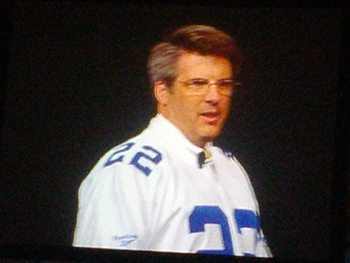
AWWA Executive Director David LaFrance
Indeed, for water professionals there is no offseason, as LaFrance went on to describe the mission at hand — fixing an ailing U.S. drinking water infrastructure system that will require $1 trillion in investment over the next 25 years. That projection, which comes from AWWA’s recently-published Buried No Longer report, was broken down by LaFrance to a mind-boggling, if slightly more digestible, $4.6 million every hour, every day, for the next quarter century. Yet he rallied attendees to the cause with his own version of a halftime speech, stating that “Someday we will break through the hole, we will get to the end zone, and we will dance.”
The Politics Of Water
The Opening General Session also featured Steve Roberts, a media professor at George Washington University (and husband of TV journalist Cokie Roberts), who offered analysis of the upcoming U.S. presidential and congressional elections and how the result could impact the water industry. Roberts wouldn’t predict a winner — only a tight race between the Democratic incumbent Barack Obama and Republican challenger Mitt Romney — but did say that Congress will likely remain divided.
And with that continued political division, we will continue the ongoing conundrum: coinciding with this $1-trillion need to modernize our water infrastructure, there is a potent wave of anti-government, anti-spending sentiment. “Americans are profoundly ambivalent — even hypocritical — on the issue of government spending,” Roberts said, noting that everyone wants clean water, but no one wants to pay for it.
“It is your job as water professionals to convince people that not all government spending is bad, that there is such a thing as productive public spending that has benefits in terms of public health and economic creation,.” Roberts continued. “Government does not provide all of the answers, but it does provide some of the answers — and one of the answers is for our crumbling infrastructure.”
In closing, Roberts advised the audience to “get past the tweets, get past the sound bites, get past the sterile debate of ‘Are you for government or against government?’ That is not the right question. The right question is ‘What is smart government?’”
Getting (More Of) The Lead Out
Speaking of political and legislative wrangling, the issue of mounting government regulations was a major topic at ACE12. Of particular concern — from my experience on the show floor and attending technical sessions – is the upcoming lead-free mandate that will take effect on January 4, 2014. The Reduction of Lead In Drinking Water Act (S.3874) actually redefines “lead free” under the Safe Drinking Water Act to mean no more than a weighted average of 0.25% lead (down from 8%) for wetted surfaces. The law covers all points from source to tap — both residential and nonresidential systems, and everything involving distribution, storage, and treatment.
Many utility workers will be turned off not only by the overhaul job on the horizon, but also by the use of lightweight composites as a potential replacement for lead-laden metal. However, after seeing the test results presented by Bridget Berardinelli, product manager for the meter manufacturer Sensus, I am convinced that fears about durability, at least for certain applications, are unfounded. As demonstrated in this video, composites have shown considerably higher yield strength and burst pressure resistance than legacy materials such as bronze.
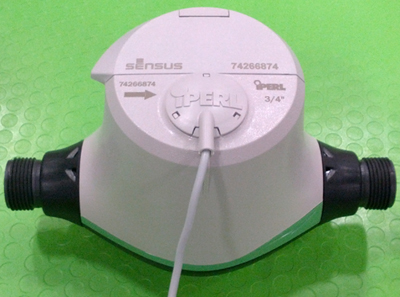
The lead-free iPERL water meter from Sensus
Without a doubt, the 2014 version of “lead free” will warrant a host of considerations, research, planning, and budgeting, so municipalities would be wise to get a foothold of the law’s nuances (definitions, exemptions, etc.) and start implementation sooner rather than later.
The White Whale Of Funding – WIFIA
So where do we get the money? That’s the common question — and a fair one, considering the state of our economy — that arises when it comes to replacing old pipes, meters, and every other aspect of our water infrastructure. WIFIA, the Water Infrastructure Finance and Innovation Authority, is a funding initiative that would provide part of the answer — if the bill gets passed. Conceived as a supplement to State Revolving Funds (SRFs), the program would access U.S. Treasury funds to create low-interest loans for water and wastewater projects that, in theory, would not add to long-term federal debt.
I spoke to two people very involved in the fight to get this legislation passed — one an executive with a bird’s eye view, and the other a plant manager working in the trenches, so to speak. The former was AWWA Executive Director LaFrance, who told me that the goal for this year is to simply gain as much traction and support as possible for the proposed WIFIA bill. When asked about the prospects of realizing the ultimate goal — signed legislation — LaFrance assured me, “We’re staying on it until it passes.”
Like LaFrance, David Weihrauch, a water treatment manager for the City of Oxford, OH, realizes that the political process is incremental but remains passionate about the cause every step of the way. “Don’t let the things that you can’t do get in the way of the things that you can,” he told me. “And what I can do is work with my congressman and others that are interested in promulgating the WIFIA legislation, and give them the tools and information they need to get the bill pushed forward.”
Weihrauch did exactly that in March, speaking to Congress as part of a “Fly-In” to draw support for WIFIA. He said he anticipates the bill to be introduced in the House of Representatives in a matter weeks, and in the Senate within a few months. Weihrauch expressed confidence in getting WIFIA passed, due in part to the trust that utilities have earned. “Water utilities have an exceptional track record as far as repayment of debt,” he said, “so we expect an exceptional score from the Congressional Budget Office with regard to borrowing federal funds.”
Those funds would go a long way toward replacing the pipes laid in 1895 that are still buried below Weihrauch’s Oxford, and the rest of our country’s aging distribution system as well.
Are You Ready For Stage 2 DBPR?
Whatever the challenges presented by infrastructure, the mission for every utility is to provide safe water. To that end, the U.S. EPA has extended the reach of the Disinfectants and Disinfection Byproducts Rule (DBPR) with Stage 2 of the rule, which kicks in for utilities serving at least 100,000 customers in January 2013. The update requires utilities to meet maximum contaminant levels as an average at each compliance-monitoring location, as opposed to the previous standard of a system-wide average. In other words, the high-quality water of one location will no longer cover for the lower-quality water of another. It will certainly protect more people, but it’s yet another hurdle for utilities to clear.
As I talked about the rule and its implications to Leo Zappa, municipal water market director for Calgon Carbon Corporation, he shared with me an interesting take on an old technique for reducing disinfection byproducts (DBPs) — granular activated carbon (GAC) — that is trending among municipalities. Rather than disposing of the spent GAC, Calgon Carbon is reactivating it for its customers to reuse. This method is cheaper and more environmentally friendly, according to Zappa, while also improving taste and odor and providing a barrier against pharmaceutical compounds and endocrine disruptors. To accommodate and build on the trend, and to make it more economical for municipalities, the company is planning the construction of additional reactivation facilities (they currently have two in operation), placed strategically within different regions of the U.S.
Taking reactivation of GAC one step further, Greater Cincinnati Water Works built its own reactivation facility, with great results. I spoke with Dick Pohlman, former supervisor of water treatment for the city of Cincinnati, who confirmed significant drops in trihalomethanes (THM) and haloacetic acids (HAA) — the DBPs targeted by the Stage 2 rule — after instituting GAC. The capital costs for building the reactivation plant were no doubt hefty (and there are, of course, alternative treatment solutions for DBPs), but Pohlman says Cincinnati’s investment is paying dividends both financially and in terms of water quality.
End Zone Dancing
Another city now notable for its excellent drinking water is Fremont, NE, due to the Fremont Department of Utilities’ victory at ACE12 in the “Best of the Best” Water Taste Test competition. Second place went to the Jordan Valley Water Conservancy District of Herriman, UT, while Arcadia Water of Arcadia, WI, claimed third place.
On the operations front, it was sheer dominance for Birmingham Water Works — again. Following a sweep of first-place finishes in the Tapping Team and Top Operators competitions, the utility boasts nine ACE Tapping Team titles to go with four world tapping titles — and a chance to compete for a fifth in England this fall. Meanwhile, the Top Operators win was Birmingham’s second in three years. I think we know the team to beat at ACE13.
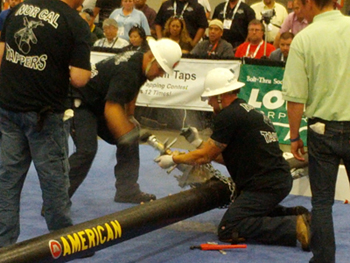
Pipe tappers hustle to keep with up with Birmingham.
Learning From The Past
From the emotional video presentation in the Opening General Session paying homage to our pipe-laying pioneers, to the convention center display of one of those old pipes (pictured below), to the keynote address about humanity’s relationship with water, there was a palpable connection to the past at this year’s ACE.
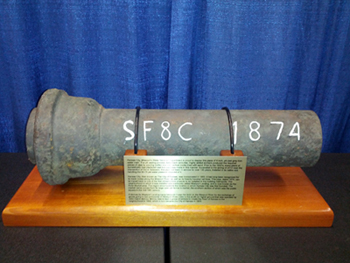
Grey-iron pipe from Kansas City, MO, circa 1874
As the water community contemplates the daunting infrastructure challenge ahead of us, we’re also reminded that this was all done once before — on a much larger scale — and that our predecessors did a very, very good job. So good, in fact, that we nearly forgot about it, and now it’s time to pay the piper — literally.
That role and duty of society to manage water responsibly was the lesson imparted by keynote speaker Dr. Brian Fagan. The archaeologist and author of Elixir: Humans and the History of Water lamented that “we take water for granted, and what we should be doing is treating it with the reverence it deserves.”
This is especially important now, he said, because of increasing population and water scarcity. According to Fagan, we have seen a 25% increase in global drought since 1990, and extreme drought will affect 30% of the world within a century, up from 3% today.
“The challenges we face — and history tells us this — are quite different from anything we have faced before,” Fagan concluded. “And how do we handle it? There’s one lesson we can learn from the past: conservation is one of the most central and important things that we can do.”
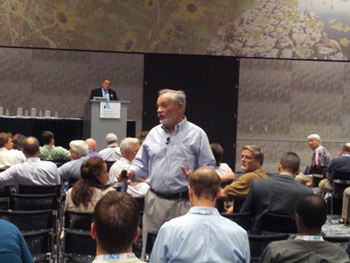
Dr. Fagan holds court on the history of water.
Moving Toward The Future
The case can be made that no one group better understands the value of water — or does more to promote it — than AWWA itself. That is evidenced by the extensive ACE12 program merely touched on here, in addition to every ACE that has preceded it. Next year’s Denver edition, however, will be spearheaded by a new AWWA president, as Jerry Stevens took his bow and handed the gavel off to incoming President Charlie Anderson as the curtains were drawn on ACE12.
Anderson is well suited to step right in, having served for four years on the AWWA Board of Directors, and also as an AWWA section director, vice president, and president-elect. He is also a CDM Smith consultant, but he really cut his teeth in the industry as the utility director and deputy city manager for the city of Arlington, TX — which is appropriate, because the job he takes on now is…yes, as big as Texas.
See also:
10 Stand-Out Technologies From ACE12
Copyright © 1996 - 2012, VertMarkets, Inc. All rights reserved. To subscribe or visit go to: http://www.wateronline.com